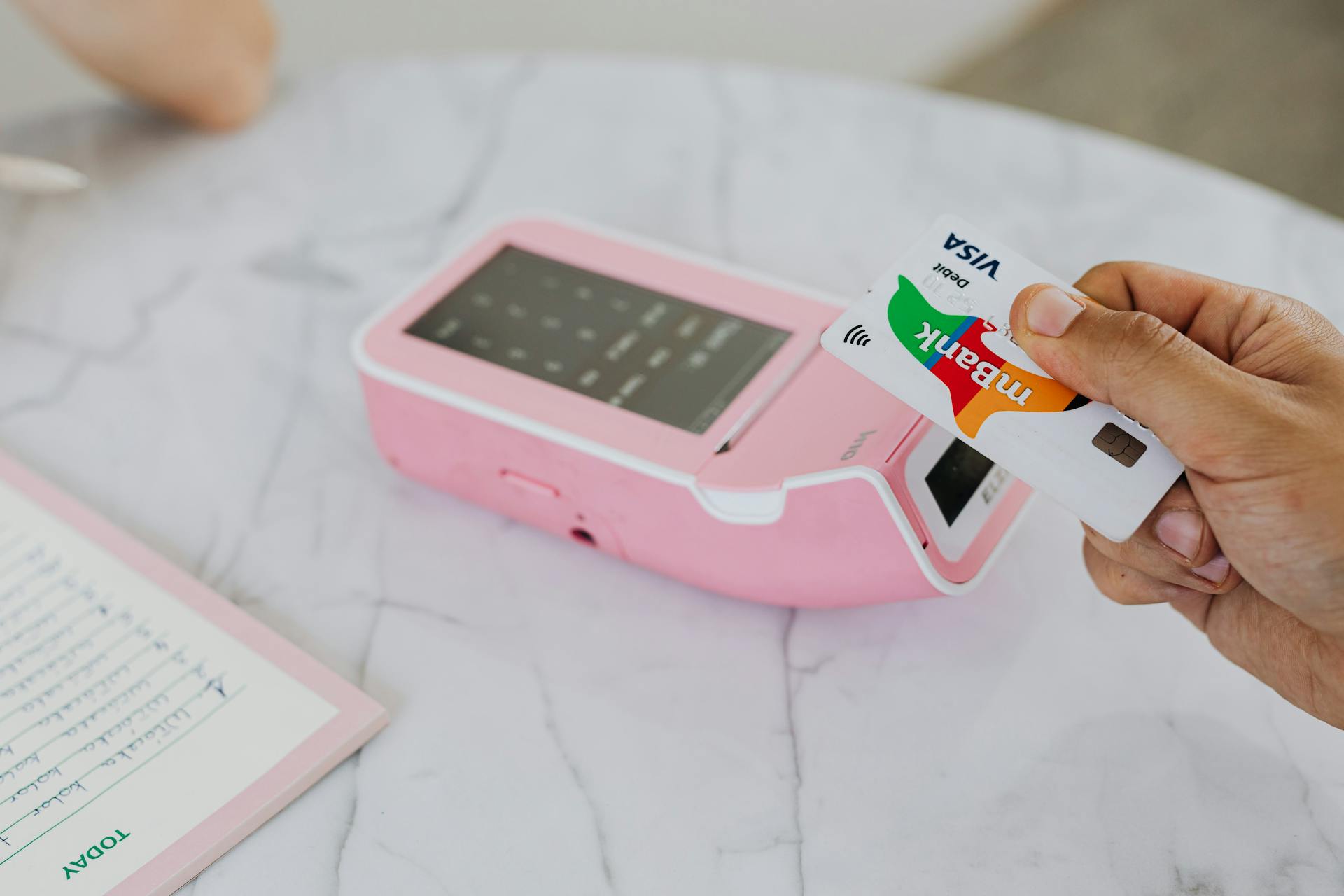
PCI DSS tokenization is a way to secure sensitive payment information by replacing it with a unique token. This token can be used for transactions without exposing the actual credit card number.
The tokenization process involves replacing the original credit card number with a randomly generated token, which is then stored in place of the actual credit card number. This ensures that even if a data breach occurs, the attackers won't have access to the sensitive payment information.
Tokenization can be done in real-time, during the payment process, or it can be done offline, as a batch process. The choice of method depends on the specific business requirements and the type of payment system being used.
Check this out: Pci Dss Information Security Policy
Benefits and Requirements
Tokenization is a game-changer for businesses looking to simplify their PCI DSS compliance journey. By reducing the financial cost associated with PCI DSS audits, businesses can save money and allocate resources elsewhere.
Tokenization also reduces the time needed to perform the PCI DSS audit, making it a more efficient process. This is especially true when using tokenization to minimize the risk of data hacks, which can be a major time-suck.
Implementing tokenization can also reduce the level of effort to implement and maintain the controls necessary for PCI DSS compliance. This is because tokenization minimizes the risk of data hacks, making it easier to achieve PCI compliance without costly security systems.
By using tokenization, businesses can protect a wide variety of payment solutions, including digital wallet credit cards, Apple Pay, Google Pay, and even cryptocurrency. This means businesses can offer their customers flexibility and choice without worrying about additional payment protection systems.
To ensure tokenization is implemented correctly, businesses should partner with a vendor who understands how to implement tokenization correctly across both technology and security/compliance/risk. A risk assessment should also be performed when selecting a tokenization service provider to ensure they are a secure entity.
Here are some key requirements to consider when selecting a tokenization service provider:
- Verify their PCI DSS compliance
- Ensure they have a secure entity
- Follow up with them each year to verify their compliance
Tokenization Process
Tokenization replaces sensitive credit card or account numbers with a token, a random alphanumeric ID with no exploitable value or meaning, to remove any connection between the transaction and the sensitive data.
This process is typically done to limit the risk of a breach of sensitive data. Tokenization of data safeguards credit card numbers and bank account numbers in a virtual vault.
Here's a simplified overview of the tokenization process:
- A credit card is swiped or entered into a system.
- The system passes the Primary Account Number (PAN) to the tokenization system.
- The tokenization system generates a token to replace the PAN and records the correlation in the data vault.
- The token is returned to the system and used to represent the customer's credit card in the system.
- The token is then sent to the payment processor, who de-tokenizes it to view the original credit card number and process payment.
In a real-time tokenized credit card transaction, the token is created from randomly generated data and sent to the acquiring bank, which uses it to request authorization from the credit card networks. The customer's actual payment data is held by their bank within a secure token vault.
See what others are reading: Card Data Covered by Pci Dss Includes
Token Separation by Format
Token Separation by Format is a crucial aspect of the tokenization process.
There are two types of token formats: format-preserving and non-format-preserving tokens.
Format-preserving tokens maintain the look and feel of the original payment card data. They are similar in appearance to a credit card, making them less effective in terms of ease of use.
A format-preserving token that protects the format is similar in appearance to a credit card, but with some changes to the numbers. For example, a card number might become 4111 8765 2345 1111.
Explore further: Multipurpose Tokens Xrpl
Non-format-preserving tokens, on the other hand, don't resemble the original data and could include both alpha and numeric characters. They are different from a credit card in terms of appearance, with no similarity in terms of card number length and characters used.
Mike Riesen, a Security Analyst, recommends that most organizations use format-preserving tokens to avoid causing validation issues with existing applications and business processes.
Check this out: Pancakeswap Tokens
How It Works
Tokenization is a process that replaces sensitive credit card or account numbers with a token, which is a unique alphanumeric ID with no exploitable value or meaning. This process limits the risk of a breach of sensitive data.
The tokenization system generates a string of random characters to replace the Primary Account Number (PAN) or retrieves the associated token if it has already been created. This token is then recorded in the data vault.
Here's a step-by-step breakdown of how tokenization works:
- A credit card is swiped in a POS machine or entered into an ecommerce site.
- The POS machine (or ecommerce site) passes the PAN to the credit card tokenization system.
- The tokenization system generates a token and records the correlation in the data vault.
- The tokenization system returns the token to the POS terminal (or ecommerce site) and is used to represent the customer’s credit card in the system.
- The token is sent to the payment processor, who de-tokenizes it and processes the payment.
In a tokenized payment process, the PAN is not transmitted during the transaction, ensuring the payment process to be secure. This means that even if the payment tokens are accessed by a hacker, the PAN is never compromised.
The tokenization system replaces the sensitive data with a token, which is a stand-in for the sensitive data that communicates where the payment request is being sent from. This token is created from randomly generated data and is used to request authorization from the relevant credit card networks.
Here's an example of how tokenization works:
- The customer makes an online purchase by providing their debit or credit card data at checkout.
- This card data is tokenized via a token service provider and sent to the acquiring bank.
- The acquirer uses this token to request authorization from the relevant credit card networks.
- The customer’s actual payment data is held by their bank within a secure token vault.
- Once the token is supplied by the credit card issuer and is matched to the account number, the bank will verify the transaction.
The best part of a correctly implemented tokenization system is that merchants never see customer credit card information. They only see tokens, which are essentially useless strings of information.
Compliance Basics
Tokenization is a data security strategy that secures sensitive data like credit card numbers by exchanging them for non-sensitive data - a token.
The PCI DSS doesn't eliminate the need for tokenization vendors to be approved through the PCI SSC, but it's a crucial step in ensuring tokenization systems and processes are protected with strong security controls.
Tokenization solutions can simplify a merchant's validation efforts by reducing the number of system components for which PCI DSS requirements apply.
See what others are reading: Credit Card Numbers with Security Code
Even with tokenization, credit card data is still considered in scope for PCI requirements, unless the card vault is handled by a third party.
To reduce PCI DSS scope, a company's technology and business processes must interact with payment card data in a way that minimizes risk.
The elements of the tokenization system, like the card vault and de-tokenization, are technically part of the cardholder data environment and therefore in scope for PCI requirements.
Related reading: Pci Dss Scope
Tokenization Examples and Capacity
Tokenization opens the door to more personalized payment experiences by enabling customers to save their payment preferences for future purchases.
In eCommerce, tokenization helps prevent credit card fraud and allows consumers to have their actual payment data safely stored on mobile devices.
A data vault is the keystone to the tokenization process, and it can hold a large number of tokens. The key difference between single-use and multi-use tokens is that single-use tokens are used for a single transaction and can cause a token collision scenario if not properly validated.
Multi-use tokens, on the other hand, can be used for multiple transactions and reduce data vault bloat and data analytics.
A token collision scenario occurs when two identical tokens are generated, but actually represent two different pieces of data.
Here's a comparison of single-use and multi-use tokens:
Token Types by Usage
Single-use tokens are processed faster than multi-use tokens.
A new token is created for each transaction, which can cause token conflicts due to the constant expansion of the token vault area.
Single-use tokens are ideal for a single transaction, but may not be the most economical choice.
The token vault area needs more space to accommodate new tokens created for each transaction.
Multi-use tokens, on the other hand, are used for many transactions and provide economical use of the vault area.
The same card information is used for multiple transactions with a multi-use token, which enables data analysis.
Tokenized Credit Card Data Examples
Tokenization in eCommerce opens the door to more personalized payment experiences by enabling customers to save their payment preferences for future purchases. This is achieved by tokenizing sensitive credit card data, which is then saved to their account.
Tokenization replaces sensitive credit card information with a token, which is a randomly generated string of numbers. This means that cardholder data and card details are never exposed during the payment process, protecting them against data breaches.
Format-preserving tokens maintain the look and feel of the original payment card data, while non-format preserving tokens don't resemble the original data and could include both alpha and numeric characters.
Here are some examples of tokenized credit card data:
Tokenized credit card data can be seen in mobile wallets, where the credit card number is replaced with a token, ensuring that sensitive data is safely stored. This also helps prevent credit card fraud and allows consumers to have their actual payment data safely stored.
A token collision scenario can occur when two identical tokens are generated, but actually represent two different pieces of data. This is why validation of previously existing tokens in the token generation process is crucial.
IxoPay
IxoPay offers a tokenization solution for PCI descoping, which can save your organization time, money, and effort by isolating sensitive data and storing only what's necessary.
Tokenization is a data-centric approach to security and compliance, providing maximum scope and risk reduction. It preserves the business utility of the original data while minimizing disruptions to existing processes.
Cloud-based tokenization models offer the greatest scope-reducing potential, making them a great option to consider. Contact IxoPay today to learn more about how they can help your organization achieve PCI compliance.
Risks and Considerations
Tokenization can introduce some risks if not implemented correctly. One of the main risks is cross-domain tokenization, where a token for one merchant can be used across all merchants in a single data vault, essentially making it a credit card.
Data commingling is another challenge, where organizations store both card data and tokens, making it difficult to determine what's a token and what's a payment card number. This can also make it hard to prove compliance with the PCI DSS.
Multiple tokenization solutions can also lead to unique card processing challenges, such as using the wrong token to process a transaction.
Risks of
Tokenization is a powerful tool for protecting sensitive data, but like any technology, it's not without its risks. Cross-domain tokenization, where a token is used across multiple merchants, can essentially make a token a credit card.
Data commingling, storing both card data and tokens in the same database, creates a challenge in determining what's a token and what's a payment card number. This makes it difficult to comply with the PCI DSS request to prove no payment card data is stored.
Using multiple tokenization solutions can lead to unique card processing challenges, such as trying to use the wrong token to process a transaction.
Here are some key risks to consider:
- Cross-domain tokenization
- Data commingling
- Using multiple tokenization solutions
If not implemented correctly, these risks can have serious consequences. However, if done right, the risks associated with tokenization remain limited.
5 Things Businesses Should Know About
Here are 5 things businesses should know about tokenization:
1. Encryption is not tokenization, and using encryption as a means of tokenization leaves a company at risk.
Consider reading: Pci Dss Encryption Requirements
Tokenization is more than just encrypting sensitive data; it's a way to replace sensitive data with a unique token, reducing the risk of data breaches.
2. Tokenization is applicable and should be used across all sensitive data sets, with the right provider.
You should consider tokenizing not just credit card data, but also other sensitive data sets, such as personal identifiable information (PII).
3. Tokenization is more about implementation than the actual technology.
The technology behind tokenization is relatively straightforward, but the key to success lies in proper implementation.
4. Tokenization provides varying degrees of scope reduction in the PCI DSS arena.
By using tokenization, businesses can reduce their scope of PCI DSS compliance, making it easier to achieve and maintain compliance.
5. There are common pitfalls to implementing tokenization correctly, so it's critical to partner with a vendor who understands how to implement tokenization correctly.
To avoid common pitfalls, businesses should carefully evaluate a provider before jumping into a new tokenization solution, and perform a risk assessment to ensure they're contracting with a secure entity.
Recommended read: Pci Compliance Risk Assessment
How Credit Cards Work
Credit cards work by replacing your sensitive card information with a token, a randomly generated string of numbers that can be used to represent your credit card in a system. This token is created by a token service provider and is used to communicate with the credit card networks.
Think of it like a casino, where players use chips to represent their money. In the same way, a token represents your credit card information, without exposing the actual data.
Here's a step-by-step explanation of how credit cards work:
1. You make an online purchase by providing your debit or credit card data at checkout.
2. Your card data is tokenized via a token service provider and sent to the acquiring bank, replacing the actual payment processor data.
3. The acquirer uses the token to request authorization from the relevant credit card networks, such as Visa or American Express.
4. Your actual payment data is held by your bank within a secure token vault, where it's matched to the token and verified.
On a similar theme: Pci Dss Service Provider Levels
5. Once the payment is successful, the payment token is returned to the merchant, and future transactions use a different token sequence.
Here's a breakdown of the key players involved in the credit card payment process:
- Token Service Provider: generates the token and replaces the actual card data
- Acquiring Bank: receives the token and requests authorization from the credit card networks
- Credit Card Networks: verifies the token and authorizes the payment
- Merchant's Bank: holds the actual payment data in a secure token vault
In a tokenized payment process, the Primary Account Number (PAN) is never transmitted during the transaction, ensuring the payment process is secure.
Frequently Asked Questions
What is the difference between card on file and tokenization?
Card on file (CoF) stores actual credit or debit card details with a merchant, while tokenization replaces these details with a unique code called a "token" for secure transactions. This distinction is crucial for protecting sensitive payment information.
What is the difference between network tokenization and PCI tokenization?
Network tokenization links tokens directly to a customer's account, whereas PCI tokenization only links tokens to the card number. This key difference affects how sensitive data is protected and accessed
Is a token considered cardholder data?
No, a token is not considered cardholder data in the traditional sense, but it is still part of the cardholder data environment (CDE) and subject to PCI DSS requirements. This means that tokens are in scope for PCI DSS regulations, just like card numbers.
Sources
- https://www.ixopay.com/en/news/pci-descoping-the-ultimate-guide-to-pci-compliance
- https://pcidssguide.com/what-is-tokenization-and-how-does-it-affect-your-pci-compliance/
- https://www.paymentsjournal.com/how-can-credit-card-tokenization-be-used-in-pci-dss-compliance/
- https://staxpayments.com/blog/credit-card-tokenization-explained/
- https://www.securitymetrics.com/blog/what-tokenization-and-how-can-i-use-it-pci-dss-compliance
Featured Images: pexels.com


